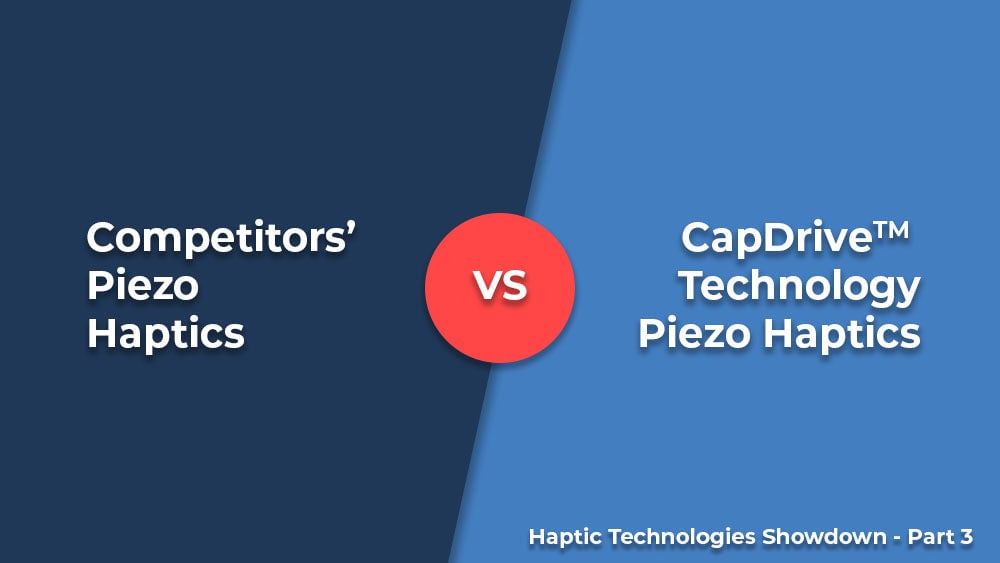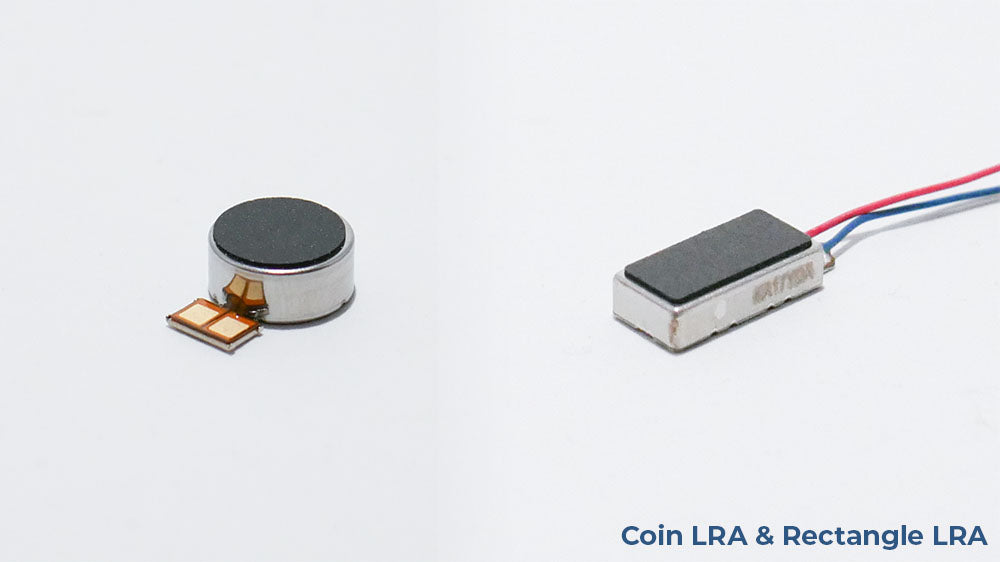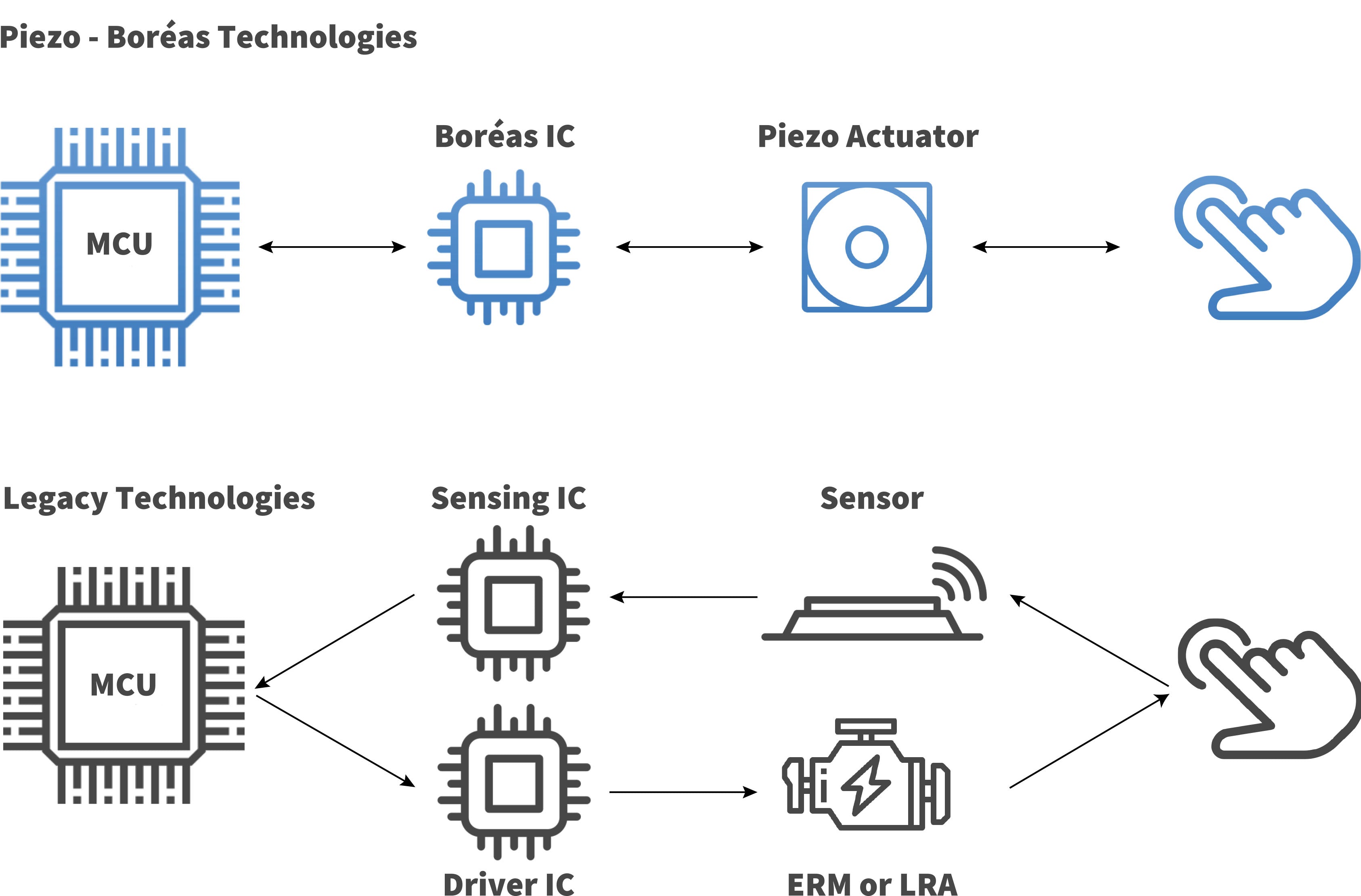
This blog article is the third and final of a series of three haptic technologies showdown. You can read the two other parts here:
Haptic technologies are evolving. We’ve seen how Eccentric Rotating Mass (ERM) motors compared to piezo haptics in the first part of our Haptic Technologies Showdown article series. We’ve seen that vibration motors are good if you need a low-cost solution. They are fairly limited in terms of feedback quality and they produce a low-end rumble instead of clear and crisp tactile effects. Therefore, high-end electronic device manufacturers have turned their attention to another haptic technology in the last years.

Linear resonant actuators (LRA) are now used in many devices to create better haptic feedback than what ERM can achieve. They offer higher acceleration, faster response time and crisper haptic feedback than ERM. LRA are based on mass movement, just like ERM motors. The difference lies in the fact that the mass is suspended on springs and is moved with a magnetic field. Form factor varies, some LRA are rectangular and some are round. Some manufacturers even developed their own version of LRA for even better results (Apple’s Taptic Engine for example), but how do they compare to piezo haptics? Let’s see!
Piezo Trumps Both ERM and LRA Acceleration
LRA haptic solutions offer a clear performance improvement over ERM motors. They can reach a slightly higher acceleration. Therefore, they can create stronger haptic feedback than ERM solutions (higher acceleration value = stronger haptic feedback).
While offering higher acceleration than ERM motors, linear resonant actuators are still plagued by the same problem as their lower-cost alternative: they need to move a mass to create vibration. While LRA can achieve their optimal frequency peak faster than ERM motors, we are talking 25 ms instead of 50 ms, they still require some time to reach it and to decelerate.
Piezo actuators can reach their optimal peak in less than 2 ms. It’s near-instantaneous acceleration makes it a better-performing solution than LRA for feedback strength. LRA used in mobile devices can reach acceleration values between 1 and 1.7 G. A similar-sized piezo actuator will be able to reach acceleration values between 2.5 and 5 G.
LRA Consumes More Power Than Piezo Actuators Coupled With Our Driver
- Eccentric Rotating Mass (ERM)
- Linear Resonant Actuator (LRA)
- Piezo - CapDriveTM
Another advantage LRA has over ERM motors is their lower power consumption. LRA consumes way less power than ERM solutions. They are better suited for battery-powered mobile devices.
In fact, LRA has been the most efficient haptic solution for years. Even more efficient than piezo haptics before our CapDriveTM Technology release.
Piezo haptics has been plagued with high-power consumption drivers for years before we released the BOS1901 integrated circuit. LRA consumes between 4 and 10 times more power than a piezo actuator coupled with our piezo driver integrated circuit.
It’s time to rethink which haptic technology you are going to use in your battery-powered devices.
LRA Offers Better Tactile Feedback than ERM Motors, but No HD Haptics
ERM motors can only generate unrefined rumble. LRA, on the other hand, can generate crisper haptic feedback. This is mainly due to their better acceleration.
Linear resonant actuators can produce crisper haptic feedback than ERMs, thanks to their resonant frequency. The resonant frequency is the narrow frequency range where you get optimal vibration to amplify the acceleration and displacement of the actuator mass. While LRA can produce crisper feedback than ERMs, the resonant frequency range is very narrow. Since the LRA frequency range is fairly limited, they don't have a large bandwidth and have a hard time creating different tactile effects. While LRA offers better performance over ERM motors, they can’t achieve the infinite frequency range of piezo actuators. You’re still limited with an LRA. Piezo actuators, on the other hand, offer an infinity of possibilities for various haptic effects.
LRA Response Time is Faster Than ERM Motors, but Still Slower Than Piezo Actuators
The second factor behind the better haptic performance of LRA over ERM motors is their faster response time. LRA, just like ERM actuators, needs to move a mass to create tactile feedback. While they did improve the response time over their lower-cost alternative, linear resonant actuators still need up to 25 ms to reach their optimal frequency range. The same applies to the deceleration period after the haptic effect.
Piezo actuators can start playing their haptic effects under 2 ms. This advantage offers the possibility to create crisper and more refined haptic feedback.
Save Hardware with Piezo Integrated Force Sensing

Another advantage of our piezo haptic driver architecture CapDriveTM Technology is the integrated piezo force sensing. The BOS1901, our first piezo driver integrated circuit based on CapDriveTM, can sense force and create tactile feedback from the same piezo actuator. This means you can remove your sensing hardware from your design when your application requires force sensing (like button replacement).
LRA Takes More Space Than Piezo Actuators
Linear resonant actuator drivers are more compact than piezo drivers. It would be normal to think that they are better suited for small devices, but when you consider the actuator size, the table turns quickly.
LRA, just like ERM actuators, are bigger than piezo actuators with similar acceleration (feedback strength). The space you’ll save with the piezo actuator will more than makeup for the space you’ll lose with the piezo driver integration.
To miniaturize the overall solution footprint, the BOS1901, our first piezo driver ic only needs 7 discrete components to work. This means it has the industry’s smallest footprint.
Boréas Technologies’ Piezo IC CapDrive Technology vs. Linear Resonant Actuator (LRA)
| Features | ERM | LRA | Piezo - CapDriveTM |
| Acceleration (g)* | 0.6 | 1.7 | 2.5 |
| Power Consumption | High | Medium | Low |
| Start-Up Time [ms] | 50 | 25 | 0.3 |
| Footprint Size | Big | Big | Miniature |
| Integrated Force Sensing | No | No | Yes |
| HD Haptics | No | No | Yes |
*with 100g mass. Acceleration is related to feedback strength. Higher number = Stronger feedback
Experiment with the Best Piezo Haptic Driver Integrated Circuit Today
The BOS1901 Development Kit is available to easily test the possibilities of piezo haptics. The Kit comes with two BOS1901 piezo haptic driver IC, a selection of piezo actuators and easy GUI software to launch various tactile effects in a couple of minutes.


Leave a comment